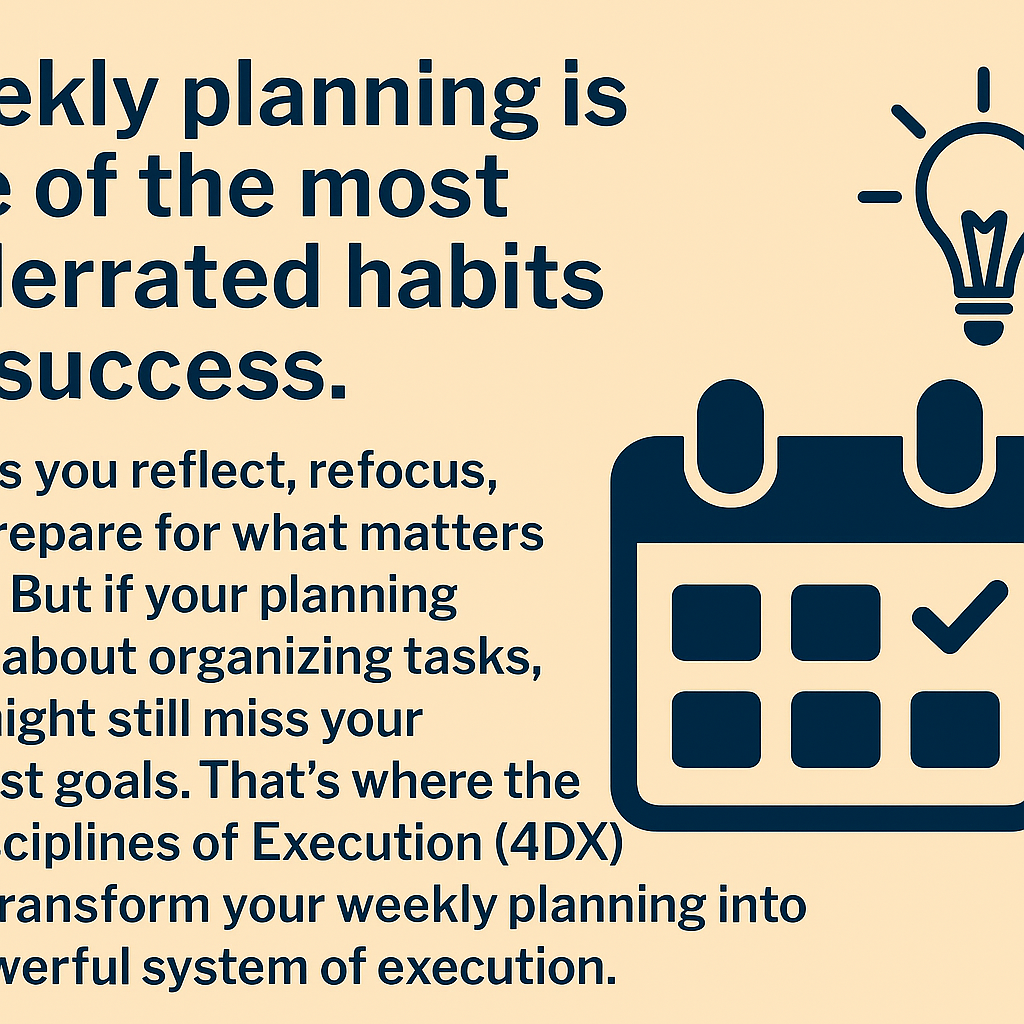Weekly planning is one of the most underrated habits for success. It helps you reflect, refocus, and prepare for what matters most. But if your planning is just about organizing tasks, you might still miss your biggest goals. That’s where the 4 Disciplines of Execution (4DX) can transform your weekly planning into a powerful system of execution.
In this article, you’ll learn how to structure your weekly planning using the 4DX method—so you stay aligned, proactive, and results-driven.
Why Weekly Planning Matters
Many people start their weeks by reacting—checking emails, attending meetings, doing “urgent” tasks. But without intention, you stay busy without making real progress.
Weekly planning with 4DX:
- Anchors your focus on your Wildly Important Goal (WIG)
- Aligns your actions with your lead measures
- Keeps you accountable and motivated
Step 1: Review Your WIG and Why It Matters
Begin each week by reconnecting with your Wildly Important Goal.
Ask:
- What is my top priority right now?
- Why is this goal important to me?
- What outcome am I driving toward?
Example:
WIG = “Grow my coaching business from 10 to 25 clients by September 30”
Write your WIG at the top of your planner or digital dashboard every week.
Step 2: Reflect on Your Lead Measures
Next, review the key actions (lead measures) that drive your WIG.
Ask:
- Did I execute my lead measures last week?
- What worked? What didn’t?
- What can I improve this week?
Examples:
- Send 5 outreach emails per day
- Publish 2 blog posts per week
- Follow up with every prospect within 24 hours
This reflection sets the tone for focused, informed action.
Step 3: Schedule Time for Your Lead Measures
Now, block time on your calendar for lead measures—before anything else.
Tips:
- Use 60–90 minute focus blocks
- Schedule lead measures early in the day or when energy is highest
- Avoid stacking other tasks on top
Example:
- Monday 9:00–10:30 = Write blog post
- Tuesday 10:00–11:00 = Outreach follow-up calls
- Thursday 7:30–8:00 = Lead measure review
Your calendar becomes your execution map.
Step 4: Update Your Scoreboard
Take 5–10 minutes to review and update your scoreboard:
- Track lead measures: Did you complete the planned actions?
- Track lag measures: Is your WIG moving forward?
- Color-code progress or use graphs to visualize momentum
Why it matters: It turns invisible effort into visible achievement—and builds motivation.
Step 5: Make a New Weekly Commitment
Each week, based on your review, choose a specific commitment.
Formula:
“I will [lead measure] [how often] this week to move toward my WIG.”
Example:
“I will host two free webinars this week to generate new client leads.”
Write this in your planner and say it out loud. This is your promise to yourself—or your team.
Step 6: Set Weekly Review Time
Choose a consistent time (e.g., Sunday evening or Friday afternoon) to repeat this planning process.
Use this rhythm to:
- Reconnect with your WIG
- Celebrate wins
- Adjust and recommit for the week ahead
Make this time sacred—because your focus deserves it.
Tools You Can Use for Weekly Planning With 4DX
- Google Calendar: Time-block your lead measures
- Notion / Trello: Track goals, habits, and scoreboards
- Physical planner: For those who prefer writing things out
- Habit tracker apps: Track your weekly consistency
The best system is the one you’ll use consistently.
Final Thought: A Week of Execution Starts With One Hour of Planning
You don’t need a perfect week to make progress—just a plan anchored in what matters most.
By using the 4DX method in your weekly planning, you shift from reacting to leading. You stop letting the whirlwind control your time—and start moving your WIG forward one focused action at a time.
